Ministry of Foreign Affairs (Soviet Union) facts for kids
| Министерство иностранных дел СССР | |
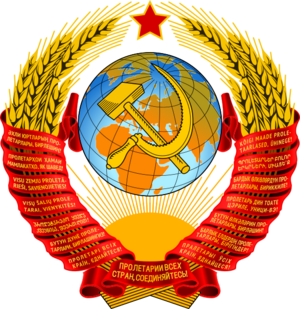
All ministry seals of the Soviet Union used the Soviet coat of arms
|
|
| Agency overview | |
|---|---|
| Formed | 6 July 1923 |
| Dissolved | 26 December 1991 |
| Superseding agency |
|
| Jurisdiction | Government of the Soviet Union |
| Headquarters | 32/34 Smolenskaya-Sennaya Square Moscow, Russian SFSR, Soviet Union |
The Ministry of Foreign Affairs of the Soviet Union was like the main office for the Soviet Union to talk with other countries. It started on July 6, 1923. Over time, it had three different names:
- People's Commissariat for Foreign Affairs (from 1923 to 1946)
- Ministry of Foreign Affairs (from 1946 to 1991)
- Ministry of External Relations (in 1991)
This Ministry was one of the most important government offices in the Soviet Union. A special leader, called the Minister, was in charge. This Minister was chosen by the head of the Soviet government and approved by the Supreme Soviet, which was like the Soviet parliament. The Ministry worked to make friends with other countries and spread Soviet ideas.
Contents
What the Ministry Did: Its Main Jobs
The main job of the Ministry was to decide how the Soviet Union would deal with other countries. It spoke for the Soviet Union in talks with foreign leaders. It also chose people to work as diplomats in other countries. These diplomats helped look after the Soviet Union's money and political interests abroad.
The Ministry also worked with other groups to protect Soviet citizens living in other countries. They helped with things like getting passports and visas for people to travel. They also helped share Soviet culture with the world. A less known part of their job was helping to coordinate Soviet intelligence (information gathering) activities in other countries.
How the Ministry Was Set Up
The Ministry had an important group called the Collegium. This group was made up of the Minister, two main assistants, and nine other assistants. In 1990, there were 27 members in the Collegium. Each assistant usually led their own department.
The Collegium helped make big decisions about the Ministry's work. They would look at new plans from the Minister and see if they were working well. For example, in 1988, they officially supported Mikhail Gorbachev's "new political thinking." This new way of thinking aimed to improve relationships with other countries. It also focused on making "decent, human, material and spiritual living conditions for all nations."
The main Ministry worked closely with its local offices in different Soviet republics. This helped all parts of the Soviet Union have a say in foreign policy. They would meet to talk about international problems and find solutions.
After 1989, many communist governments in Eastern Europe changed. Because of this, the Ministry no longer needed separate departments for Eastern and Western Europe. In 1986, new departments were created to deal with arms control (limiting weapons) and disarmament (getting rid of weapons). New regional departments were also added, like one for the Pacific region. This was a big change because the Ministry's structure had stayed mostly the same since the time of the Russian Empire.
A Soviet textbook described how the Ministry was set up: "Important parts of the central office deal with daily diplomatic work. These parts are organized by regions and what they do. Regional departments handle foreign relations with specific groups of countries, divided by areas."
In 1986 and 1987, many top diplomats were replaced. A new rule was also made: "If an ambassador stays in the same job for 4 or 5 years, they lose their sharp thinking. The best time to serve in one job is three years at most."
Ideas and Policies
The ideas of Marxism-Leninism were very important to Soviet foreign policy. Vladimir Lenin, a key Soviet leader, believed in finding common ground and living peacefully with capitalist countries. The main goal of this peaceful approach was to stop other powerful countries from attacking the Soviet Union. This was especially important while the Soviet Union was rebuilding after the Russian Civil War and building its industries. So, sometimes, agreements with capitalist countries were made to help socialism.
The relationship between ideas and actual policy was always a big topic until the Soviet Union broke apart. Some believed that all successful Soviet diplomatic work was based on Marxist-Leninist ideas. The Ministry had a group that studied international relations and tried to guess future events. However, this group didn't actually plan the Ministry's policies. Eduard Shevardnadze, a Soviet foreign minister, said that Gorbachev's "new thinking" helped keep stable diplomatic relations around the world.
There was often a friendly competition between the government (represented by the Ministry) and the Communist Party (represented by its International Department). The Party's approach to foreign policy was more about spreading communist ideas. The Ministry, however, often focused on "détente" – easing tensions with Western countries.
Historian Jan Adams explained this difference: "There was a deep and constant conflict between these two main Soviet foreign policy groups. The Ministry of Foreign Affairs wanted to build official relationships between countries. But the International Department wanted to build a communist world and weaken capitalism."
The Soviet Ministry of External Relations spent a lot more money and effort on propaganda and "active measures" than other countries' foreign ministries. This included spreading Soviet views, bothering opponents, blocking radio signals, creating fake documents, and spreading false information. Because of this, the Soviet Ministry usually had a much bigger budget than Western foreign ministries. Shevardnadze said that the Soviet government spent about 700 billion rubles just on the Ministry of Foreign Affairs to support "ideological fights" with the Western world.
History of the Ministry
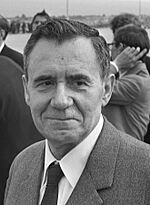
The first version of this Ministry was set up in 1917. It was called the People's Commissariat for Foreign Affairs of the Russian Soviet Federative Socialist Republic (RSFSR). This new office replaced the old Ministry of Foreign Affairs of the Russian Empire after the October Revolution. In 1946, the name changed to the Ministry of Foreign Affairs.
Andrei Gromyko, who was a Soviet foreign minister for a long time, wrote in his memoirs that working with Nikita Khrushchev was not always easy. Gromyko said Khrushchev "would constantly throw new ideas back and forth." Not all his ideas were popular, but Gromyko felt Khrushchev had a good impact on Soviet foreign policy.
Gromyko also said that Leonid Brezhnev was easier to work with. Brezhnev would talk openly about things in the Politburo, even if he wasn't an expert. However, Brezhnev's slow pace and lack of knowledge in some areas made foreign policy discussions difficult. Gromyko noted that Brezhnev's health should be considered.
Mikhail Gorbachev's "new thinking" led to better relationships with Western countries. But his policies inside the country caused problems, and in 1991, the Soviet Union broke apart. Before it dissolved, the Ministry was renamed the Ministry of External Relations. In 1992, the Ministry of Foreign Affairs of the Russian Federation took its place.
Leaders of the Ministry
Here are the people who led the Ministry during the Soviet era:
| No. | Portrait | Name (birth–death) |
Term | Cabinet | ||
|---|---|---|---|---|---|---|
| Took office | Left office | Duration | ||||
| People's Commissar for Foreign Affairs of the USSR | ||||||
| 1 | Georgy Chicherin (1872–1936) |
6 July 1923 | 21 July 1930 | 7 years, 15 days | Lenin II Rykov I–II–III–IV–V |
|
| 2 | Maxim Litvinov (1876–1951) |
21 July 1930 | 3 May 1939 | 8 years, 286 days | Molotov I–II–III–IV | |
| 3 | Vyacheslav Molotov (1890–1986) |
3 May 1939 | 15 March 1946 | 6 years, 305 days | Molotov IV Stalin I–II |
|
| Minister of Foreign Affairs of the USSR | ||||||
| 3 | Vyacheslav Molotov (1890–1986) |
19 March 1946 | 4 March 1949 | 2 years, 350 days | Stalin II | |
| 4 | Andrey Vyshinsky (1883–1954) |
4 March 1949 | 5 March 1953 | 4 years, 1 day | Stalin II | |
| (3) | Vyacheslav Molotov (1890–1986) |
5 March 1953 | 1 June 1956 | 3 years, 88 days | Malenkov I–II Bulganin |
|
| 5 | Dmitri Shepilov (1905–1995) |
1 June 1956 | 15 February 1957 | 259 days | Bulganin Khrushchev I |
|
| 6 | Andrei Gromyko (1909–1989) |
15 February 1957 | 2 July 1985 | 28 years, 137 days | Khrushchev I–II Kosygin I–II–III–IV–V Tikhonov I–II |
|
| 7 | Eduard Shevardnadze (1928–2014) |
2 July 1985 | 15 January 1991 | 5 years, 197 days | Tikhonov II Ryzhkov I–II |
|
| 8 | Alexander Bessmertnykh (born 1933) |
15 January 1991 | 28 August 1991 | 225 days | Pavlov | |
| – | Boris Pankin (born 1931) Acting |
28 August 1991 | 18 November 1991 | 82 days | Silayev | |
| Minister of External Relations of the USSR | ||||||
| (7) | Eduard Shevardnadze (1928–2014) |
19 November 1991 | 26 December 1991 | 37 days | Silayev | |
First Deputy Ministers
Ten people served as the First Deputy Minister. Vasily Kuznetsov held the job for the longest time, serving 22 years. Vladimir Petrovsky served the shortest time, for 96 days.
| No. | Portrait | Name (birth–death) |
Term | Cabinet | ||
|---|---|---|---|---|---|---|
| Took office | Left office | Duration | ||||
| First Deputy Minister of Foreign Affairs of the Soviet Union
(1953–1991) |
||||||
| 1 | Andrei Gromyko (1909–1989) |
20 July 1953 | 15 February 1957 | 3 years, 179 days | Malenkov I–II Bulganin Khrushchev I |
|
| 2 | Vasily Kuznetsov (1901–1990) |
15 February 1955 | 7 October 1977 | 22 years, 234 days | Khrushchev I–II Kosygin I–II–III–IV |
|
| 3 | Nikolai Patolichev (1908–1989) |
18 March 1957 | 7 January 1958 | 295 days | Bulganin I | |
| 4 | Georgy Korniyenko (1925–2006) |
7 October 1977 | 27 April 1986 | 8 years, 202 days | Kosygin IV Tikhonov I–II Ryzhkov I |
|
| 5 | Viktor Maltsev (1917–2003) |
24 December 1977 | 27 May 1986 | 8 years, 154 days | Kosygin IV Tikhonov I–II Ryzhkov I |
|
| 6 | Anatoly Kovalev (1923–2002) |
27 May 1986 | 26 December 1991 | 5 years, 213 days | Ryzhkov I–II Pavlov Silayev |
|
| 7 | Yuli Vorontsov (1929–2007) |
27 May 1986 | 24 February 1990 | 3 years, 273 days | Ryzhkov I–Ryzhkov II | |
| 8 | Alexander Bessmertnykh (born 1933) |
8 July 1988 | 25 April 1990 | 1 year, 291 days | Ryzhkov I–Ryzhkov II | |
| 9 | Yuli Kvitsinsky (1936–2010) |
12 May 1991 | 21 September 1991 | 132 days | Pavlov Silayev |
|
| 10 | Vladimir Petrovsky (1933–2014) |
21 September 1991 | 26 December 1991 | 96 days | Silayev | |
Images for kids
See also
- Ministries of the Soviet Union
- List of Russian foreign ministers
- Foreign relations of the Soviet Union



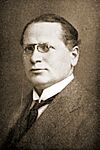
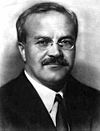
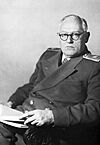

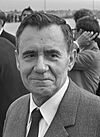

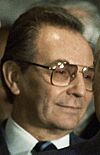

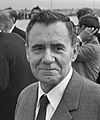


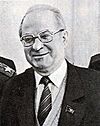
![Viktor Maltsev [ru]](/images/6/6d/No_image.png)
![Anatoly Kovalev [ru]](/images/thumb/a/ae/AGK_Portrait.jpg/100px-AGK_Portrait.jpg)
